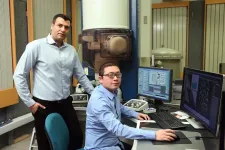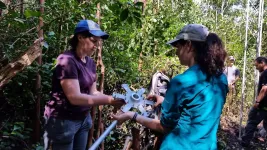Machine learning accelerates discovery of materials for use in industrial processes
Platform aims to minimize resources required in the development of new materials for use in targeted applications
2021-01-11
(Press-News.org) TORONTO, ON - New research led by researchers at the University of Toronto (U of T) and Northwestern University employs machine learning to craft the best building blocks in the assembly of framework materials for use in a targeted application.
The findings, published today in Nature Machine Intelligence, demonstrated that the use of artificial intelligence (AI) approaches can help in proposing novel materials for diverse applications. One example is the separation of carbon dioxide from industrial combustion processes. AI approaches promise the acceleration of the design cycle for materials.
With the objective of improving the separation of chemicals in industrial processes, the team of researchers - including collaborators from Harvard University and the University of Ottawa - set out to identify the best reticular frameworks (e.g., metal organic frameworks, covalent organic frameworks) for use in the process. Such frameworks, which can be thought of as tailored molecular "sponges", form via the self-assembly of molecular building blocks into different arrangements and represent a new family of crystalline porous materials that have been proven to be promising in addressing many technology challenges (e.g., clean energy, sensoring, biomedicine, etc.)
"We built an automated materials discovery platform that generates the design of various molecular frameworks, significantly reducing the time required to identify the optimal materials for use in this particular process," says Zhenpeng Yao, a postdoctoral fellow in the Departments of Chemistry and Computer Science in the Faculty of Arts & Science at U of T, and lead author of the study. "In this demonstrated employment of the platform, we discovered frameworks that are strongly competitive against some of the best-performing materials used for CO2 separation known to date."
The perennial challenges in addressing CO2 separation and other problems like greenhouse gas reduction and vaccine development, however, are the unpredictable amount of time and extensive trial-and-error efforts required in the pursuit of such new materials. The occasionally infinite combinations of molecular building blocks available in the construction of chemical compounds can mean the exhaustion of significant amounts of time and resources before a breakthrough is made.
"Designing reticular materials is particularly challenging, as they bring the hard aspects of modeling crystals together with those of modeling molecules in a single problem," says senior coauthor Alán Aspuru-Guzik, Canada 150 Research Chair in Theoretical Chemistry in the Departments of Chemistry and Computer Science at U of T and Canada CIFAR AI Chair at the Vector Institute. "This approach to reticular chemistry exemplifies our emerging focus at U of T of accelerating materials development by means of artificial intelligence. By using an AI model that can 'dream' or suggest novel materials, we can go beyond the traditional library-based screening approach."
The researchers focused on the development of metal-organic frameworks (MOFs) that are now considered the ideal absorbing material for the removal of CO2 from flue gas and other combustion processes.
"We began with the construction of a large number of MOF structures on the computer, simulated their performance using molecular-level modeling, and built a training pool applicable to the chosen application of CO2 separation," said study co-author Randall Snurr, the John G. Searle Professor and chair of the Department of Chemical & Biological Engineering in the McCormick School of Engineering at Northwestern University. "In the past, we would have screened through the pool of candidates computationally and reported the top candidates. What's new here is that the automated materials discovery platform developed in this collaborative effort is more efficient than such a "brute force" screening of every material in a database. Perhaps more importantly, the approach uses machine learning algorithms to learn from the data as it explores the space of materials and actually suggests new materials that were not originally imagined."
The researchers say the model shows great prediction and optimization capability in the design of novel reticular frameworks, particularly in combination with already known candidates in specific functions, and that the platform is fully customizable in its application to address many contemporary technology challenges.
INFORMATION:
The research was supported by the Office of Science at the United States Department of Energy, the Canadian Network for Research and Innovation in Machining Technology, and the Natural Sciences and Engineering Research Council of Canada.
MEDIA CONTACTS:
Zhenpeng Yao
Departments of Chemistry & Computer Science
Faculty of Arts & Science
University of Toronto
yaozhenpeng@gmail.com
Alán Aspuru-Guzik
Departments of Chemistry & Computer Science
Faculty of Arts & Science
University of Toronto
aspuru@utoronto.ca
Randall Snurr
Department of Chemical & Biological Engineering
McCormick School of Engineering
Northwestern University
snurr@northwestern.edu
Sean Bettam
Communications and Media Relations Specialist
Faculty of Arts & Science
University of Toronto
s.bettam@utoronto.ca
Julianne Hill
Director of Communications
McCormick School of Engineering
Northwestern University
julianne.hill@northwestern.edu
[Attachments] See images for this press release:

ELSE PRESS RELEASES FROM THIS DATE:
2021-01-11
'This effort truly represents a "moonshot" in COVID-19 research'
Scientists identify target to treat COVID pneumonia and reduce severity
Clinical trials with new experimental drug to begin early in 2021
Goal is to develop treatments that make COVID-19 no worse than a common cold
First comparison between immune mechanisms driving COVID-19 pneumonia with other pneumonias
CHICAGO --- Bacteria or viruses like influenza that cause pneumonia can spread across large regions of the lung over the course of hours. In the modern intensive care unit, these bacteria or viruses are usually controlled either by antibiotics or by the body's immune system within ...
2021-01-11
How are networks of neurons connected to make functional circuits? This has been a long standing question in neuroscience. To answer this fundamental question, researchers from Boston Children's Hospital and Harvard Medical School developed a new way to study these circuits and in the process learn more about the connections between them.
"Neural networks are extensive, but the connections between them are really small," says Wei-Chung Allen Lee, PhD, of the F.M. Kirby Neurobiology Center at Boston Children's and Harvard Medical School. "So, we have had to develop techniques to see them in extremely high-resolution over really large areas and volumes." ...
2021-01-11
ORLANDO, Jan. 11, 2021 - Data from Arecibo Observatory in Puerto Rico has been used to help detect the first possible hints of low-frequency disturbances in the curvature of space-time.
The results were presented today at the 237th meeting of the American Astronomical Society, which was held virtually, and are published in The Astrophysical Journal Letters. Arecibo Observatory is managed by the University of Central Florida for the National Science Foundation under a cooperative agreement.
The disturbances are known as gravitational waves, which ripple through space as a result of the movement of incredibly massive objects, such as black holes orbiting one another or the collision of neutron stars.
It's important to understand these waves as they provide insight into the history ...
2021-01-11
CAMBRIDGE, MA -- When we experience a new event, our brain records a memory of not only what happened, but also the context, including the time and location of the event. A new study from MIT neuroscientists sheds light on how the timing of a memory is encoded in the hippocampus, and suggests that time and space are encoded separately.
In a study of mice, the researchers identified a hippocampal circuit that the animals used to store information about the timing of when they should turn left or right in a maze. When this circuit was blocked, the mice were unable to remember which way they were supposed to turn next. However, disrupting the circuit ...
2021-01-11
North Carolina State University-led researchers have developed an analytical measurement "framework" which could allow organic solar cell researchers and manufacturers to determine which materials will produce the most stable solar cells prior to manufacture.
Organic solar cells have increased in efficiency over the past decades, but researchers and manufacturers still struggle with determining which material combinations work best and why, as well as with achieving stable morphology and operation.
"There is still a lot of 'trial and error' guesswork involved in identifying promising materials for these solar cells," says Harald Ade, Goodnight Innovation Distinguished Professor of Physics at NC State and co-corresponding author of the research. ...
2021-01-11
Two studies in today's Nature Neuroscience, led by researchers at Boston Children's Hospital, Brigham and Women's Hospital (BWH), and Harvard Medical School (HMS), implicate mosaic mutations arising during embryonic development as a cause of autism spectrum disorder (ASD). The findings open new areas for exploring the genetics of ASD and could eventually inform diagnostic testing.
Mosaic mutations affect only a portion of a person's cells. Rather than being inherited, they arise as a "mistake" introduced when a stem cell divides. A mutation in a stem cell will only be passed to the cells that descend from it, producing the mosaic pattern. ...
2021-01-11
Reza Shahbazian-Yassar, professor of mechanical and industrial engineering at the University of Illinois Chicago.
Shahbazian-Yassar and colleagues facilitated the development of a cutting edge "Swiss Army knife" catalyst made up of 10 different elements - each of which on its own has the ability to reduce the combustion temperature of methane - plus oxygen. This unique catalyst can bring the combustion temperature of methane down by about half - from above 1400 degrees Kelvin down to 600 to 700 degrees Kelvin.
Their findings are reported in the journal Nature Catalysis.
In previously-published research, ...
2021-01-11
Tales of post-apocalyptic landscapes in which few survivors emerge into a new and much different world have long been popular tales woven by screenwriters and authors. While many enjoy these stories, thinking of them as nothing but a guilty pleasure, they may not realize that immersing themselves in fiction has prepared them for the reality of 2020, according to a team of researchers.
John Johnson, professor emeritus of psychology at Penn State, recently conducted research with several colleagues revealing that an individual's enjoyment of horror films could have better prepared them for the COVID-19 pandemic as opposed to others who do not enjoy frightening entertainment. Their findings are documented in Personality and Individual Differences.
"My latest ...
2021-01-11
The first-ever study of the levels of the stress hormone cortisol in the saliva of newborn white-tailed deer fawns yielded thought-provoking results that have Penn State researchers suggesting predation is not the only thing in the wild killing fawns.
"We think the hormone offers a way to evaluate factors in the environment that affect fawns, such as disease, but are difficult to evaluate when just looking at a carcass that has been picked over by predators," said researcher Duane Diefenbach, adjunct professor of wildlife ecology. "By then, it's impossible to be certain what ...
2021-01-11
University of Wyoming researchers headed a study that shows nonnative birds in Oahu, Hawaii, have taken over the role of seed dispersal networks on the island, with most of the seeds coming from nonnative plants.
"Hawaii is one of the most altered ecosystems in the world, and we are lucky enough to examine how these nonnative-dominated communities alter important processes, such as seed dispersal," says Corey Tarwater, an assistant professor in the UW Department of Zoology and Physiology. "What we have found is that not only do nonnative species dominate species ...
LAST 30 PRESS RELEASES:
[Press-News.org] Machine learning accelerates discovery of materials for use in industrial processes
Platform aims to minimize resources required in the development of new materials for use in targeted applications




